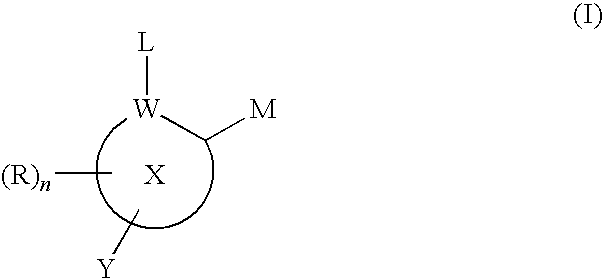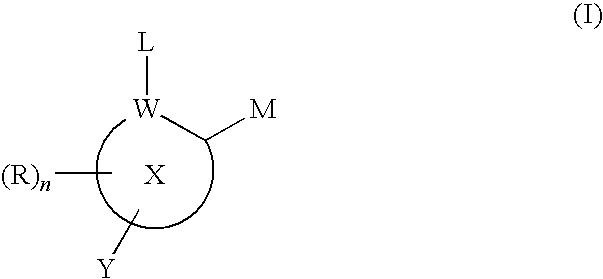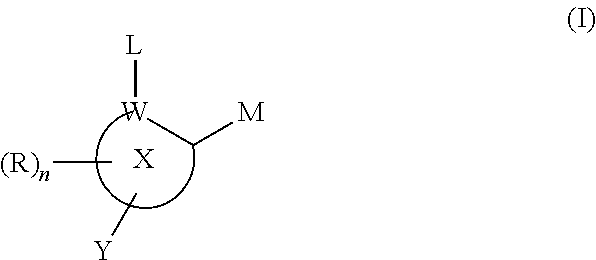Inhibitors of histone deacetylase
a technology of histone deacetylase and inhibitors, which is applied in the direction of anti-antineoplastic agents, drug compositions, organic chemistry, etc., can solve the problems of less desirable as an inhibitor or therapeutic agen
- Summary
- Abstract
- Description
- Claims
- Application Information
AI Technical Summary
Benefits of technology
Problems solved by technology
Method used
Image
Examples
example 1a
N-hydroxybiphenyl-2-carboxamide 2 N-hydroxybiphenyl-2-carboxamide 2
[0407]A solution of 2-biphenylcarboxylic acid 1 (0.25 g, 1.261 mmol), BOP (0.558 g, 1.261 mmol), hydroxylamine hydrochloride (0.088 g, 1.261 mmol) and triethylamine (0.527 mL, 3.78 mmol) was stirred in pyridine (5 mL) at room temperature overnight then diluted with DCM, washed with water (2×), dried over MgSO4, filtered and solvent evaporated to provide title compound 2 (8.8 mg, 3% yield) as a white solid after purification by Biotage (50 to 100% EtOAc in Hexane) followed by trituration (Et2O). 1H NMR (400 MHz, DMSO-d6) δ (ppm): 10.77 (s, 1H), 8.97 (s, 1H), 7.52 to 7.42 (m, 1H), 7.40 to 7.33 (m, 8H). LRMS (ESI): (calc.) 213.23 (found) 214.2 (MH)+
TABLE 1Compounds according to Scheme 1.ExCompoundStructureNameCharacterization1b3N-hydroxydibenzo [b,d]furan-4- carboxamide(DMSO-d6) δ (ppm) 1H: 11.11 (bs, 1H), 9.33 (bs, 1H), 8.29 (dd, J = 7.6, 1.2 Hz, 1H), 8.20 (dd, J = 7.8, 0.6 Hz, 1H), 7.77 (d, J = 5.1 Hz, 1H), 7.75 (dd, ...
example 2a
N-hydroxy-5-methoxy-2-(thiophen-2-yl)benzamide 11
Step 1: methyl 5-methoxy-2-(thiophen-2-yl)benzoate 10
[0408]To a degassed solution of methyl 2-bromo-5-methoxybenzoate 8 (0.25 g, 1.020 mmol), 2-thiophene boronic acid 9 (0.170 g, 1.326 mmol), tri-o-tolylphosphine (0.093 g, 0.306 mmol), and K2CO3 (0.423 g, 3.06 mmol) in DME (3 mL) and water (1 mL) was added Pd(Ph3P)4 (0.077 g, 0.066 mmol) and the reaction mixture was placed in a preheated oil bath at 85° C. and stirred overnight. The next morning the reaction was complete by HPLC therefore it was solvent evaporated, diluted with DCM, washed with water, brine, dried over MgSO4, filtered and solvent evaporated to provide compound 10 (0.13 g, 52% yield) as a colorless oil after purification by Biotage (0 to 10% EtOAc in Hexane). LRMS (ESI): (calc.) 248.05 (found) 249.1 (MH)+
Step 2: N-hydroxy-5-methoxy-2-(thiophen-2-yl)benzamide 11
[0409]To a stirring solution of methyl 5-methoxy-2-(thiophen-2-yl)benzoate 10 (0.13 g, 0.524 mmol) and a solut...
example 3a
N-hydroxy-2-(phenylethynyl)benzamide 37
Example 3b
N-hydroxy-2-phenethylbenzamide 38
Step 1: Methyl 2-(phenylethynyl)benzoate 36
[0410]To a solution of methyl 2-bromobenzoate 34 (166 μL, 1.163 mmol) in acetonitrile (2906 μL) was added triethylamine (972 6.98 mmol) and phenylacetylene 35 (140 μl, 1.279 mmol). Then copper (I) iodide (11.07 mg, 0.058 mmol), and bis(triphenylphosphine)-palladium(II) chloride (20.40 mg, 0.029 mmol), were successively added, degassing between and after each addition of catalysts. The mixture was stirred at 75° C. overnight. The reaction mixture was partitioned between EtOAc and 1M HCl. The aqueous layer was extracted with fresh EtOAc and the combined organic layers were washed with water, brine, dried over MgSO4. The residue was purified via Biotage using EtOAc / Hex ((0:100 to 10:90); 25+S column), to afford compound 36 (157 mg, 57%). LRMS (ESI): (calc.) 236.08 (found) 237.2 (MH)+
Step 2: N-hydroxy-2-(phenylethynyl)benzamide 37
[0411]In a 100 mL round-bottomed f...
PUM
 Login to View More
Login to View More Abstract
Description
Claims
Application Information
 Login to View More
Login to View More - Generate Ideas
- Intellectual Property
- Life Sciences
- Materials
- Tech Scout
- Unparalleled Data Quality
- Higher Quality Content
- 60% Fewer Hallucinations
Browse by: Latest US Patents, China's latest patents, Technical Efficacy Thesaurus, Application Domain, Technology Topic, Popular Technical Reports.
© 2025 PatSnap. All rights reserved.Legal|Privacy policy|Modern Slavery Act Transparency Statement|Sitemap|About US| Contact US: help@patsnap.com



